Woodland runs to a total of 306 acres in old money and covers a wide variety from straight commercial forestry to amenity woodland.
Some of the woods date from well back and we suspect were planted as policy woodlands to improve the view from Ravenstone Castle. This particular wood is planted on good arable ground and inspection of old ordnance survey maps shows it in place as at 1850. This woodland is mainly hardwoods or deciduous trees and includes Beech, Oak, Ash and Sweet Chesnut as well as birch willow and alder.
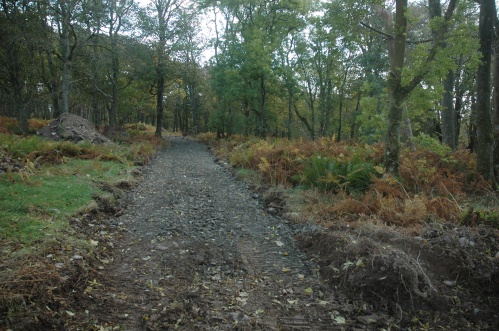
Its not easy to get decent photo of a wood – the ferns indicate a mature and possibly very old woodland although we understand that the parcel was clearfelled in 1945 they obviously left some old trees untouched since many of the trees are much older than 75 years. The roadway follows the line of the old estate road as obvious on the ground and indicated on the old maps. It has been upgraded to allow access into one of the commercial blocks – all the stone came from the farm.
Airies Knowes previously formed a small part of Ravenstone Estate which also included amongst others the farms of East and West Drummodie, Dowalton, Drumrae, Drumgin, Ravenstone Mains, Grennan and Machar Stewart. The estate was last in the ownership of a family called Fletcher which I believe was based in Yorkshire but went bankrupt in the early to mid 1960’s.
It is understood that the estate factor, a local solicitor, brokered a deal whereby all the tenants purchased the farms they were in at the time – with some consolidation here and there and in several cases these farms remain in the ownership of the same families.
The estate also owned several areas of peat bog, locally referred to as mosses, and these together with the existing woodlands, a derelict castle dating from the 1600s (since partially rebuilt) and some run down houses were purchased by the Forestry Commission – all at a total price of £1500!
The Commission planted these mosses in the early 1970s with a mix of lodgepole pine and sitka spruce which was the flavour of the day in planting terms, the idea being that the lodgepole would help to draw the sitka up and encourage straight, lightly limbed growth before eventually being shaded out and killed off by the sitka. In large parts this has worked and in general there is a good crop of Sitka which is now ready for harvest. The Commission gradually divested itself of this portfolio and for our sins we ended up buying the woodland blocks of Grennan and Auchness mosses in 1996.
Its worth mentioning at this point that a proposal to plant on such a site nowadays would be rejected on environmental grounds, nor is the wall to wall planting of conifers permitted. We have prepared and are trying to follow a 20 year plan to restructure the woodlands in line with modern standards.
Although very often described as boring monoculture and destitute of wildlife this has not been our experience in these blocks, we have a range of common wildlife including badgers and roe deer and a few not quite so common red squirrels. We also get considerable falls of woodcock in the winter months and have a fairly diverse bird population
Grennan moss is very obviously a former peat cutting site and the raised extraction roads provide easy digging and dry lies for burrowing animals while the surrounding farmland offers good feeding habitat convenient to seldom disturbed shelter.
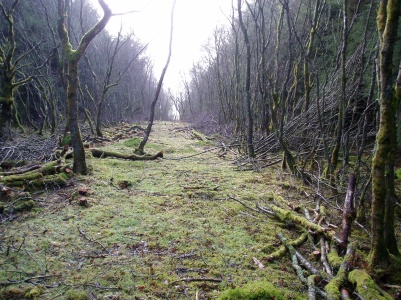
In addition the woods received little in the way of routine maintenance and the rides grew a fair crop of willow and birch without any assistance together with a proportion of hawthorn brought in by birds, to the extent that walking along (or more accurately fighting your way through) a ride was a challenge which frequently required the use of hands and knees.
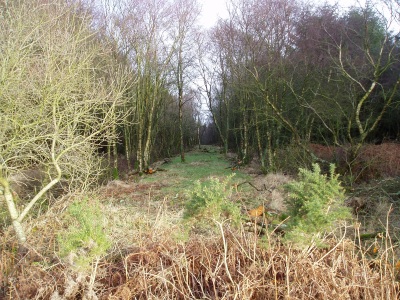
This is the same ride seen from the other end and taken on the same day. This particular ride is actually the route of an old roadway which ends up at Sorbie.
White Loch
By no means a commercial woodland the White Loch is a great and diverse habitat, the wood includes the White Loch which old maps show as being some 8 acres in extent, this however is only the remant of the loch left after an attempt to drain it completely (around 1860) proved ineffective and left only an area of swampy ground.
The loch must have been a fairly significant feature before being drained since there is a very distinctive Crannog – an artificial island about 50 yards from what would have been the original shoreline and there is also the site of a former Ravenstone Castle in an adjoining field – this castle would, with the loch at its former level, have been almost if not totally water surrounded. At a guess most of the stone from this castle will have been used to build the new Castle or found its way into nearby farm buildings.
The ordance survey maps from the 1860s show the drained loch as an area of open water surrounded by mudflats, in the intervening period the open water has disappeared into a bed of phragmites reeds, it is possible to walk across this in a dry summer but definately not for the nervous and frankly not to be recommended – I was younger then and perhaps just a little more foolish.

The mudflats have been taken over by alder and willow which have both done remarkably well. The Crannog is about 10m away and is invisible – folks have driven from Edinburgh to inspect it and gone home without finding it.
The Commission tried to “improve” the wood in the 1970s by planting both larch and Sitka – both of which have actually done fine but not really in commercial quantities – there is presently about 200t of each in this wood. In addition to the Sitka and Larch we have a very strong undercurrent of mixed woodland – birch, wych elm and sycamore, current plans are to remove the conifers and thin out the sycamore considerably while encouraging the other species.
 Winter thinning in progress, this was a program to respace the hardwoods and reduce the proportion of sycamore growing
Winter thinning in progress, this was a program to respace the hardwoods and reduce the proportion of sycamore growing
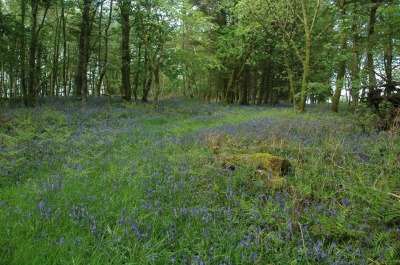
The thinning process allowed the bluebells to reassert themselves come the springtime and the wood is effectively a complete carpet of bluebells in May
This is a work which has been in progress for a number of years and to date we have considerably thinned the wood out and removed part of the conifers but this is still to complete. One of the things we have managed to do is to follow the old roadways marked on the OS 1907 map which could still be differentiated by the trees although the old gates and gateways were a good starting point.

We have always had an ambition to open up some of the water to further diversify or rather re-diversify the habitat and make it more waterfowl friendly and we have an ongoing project to try to achieve this.
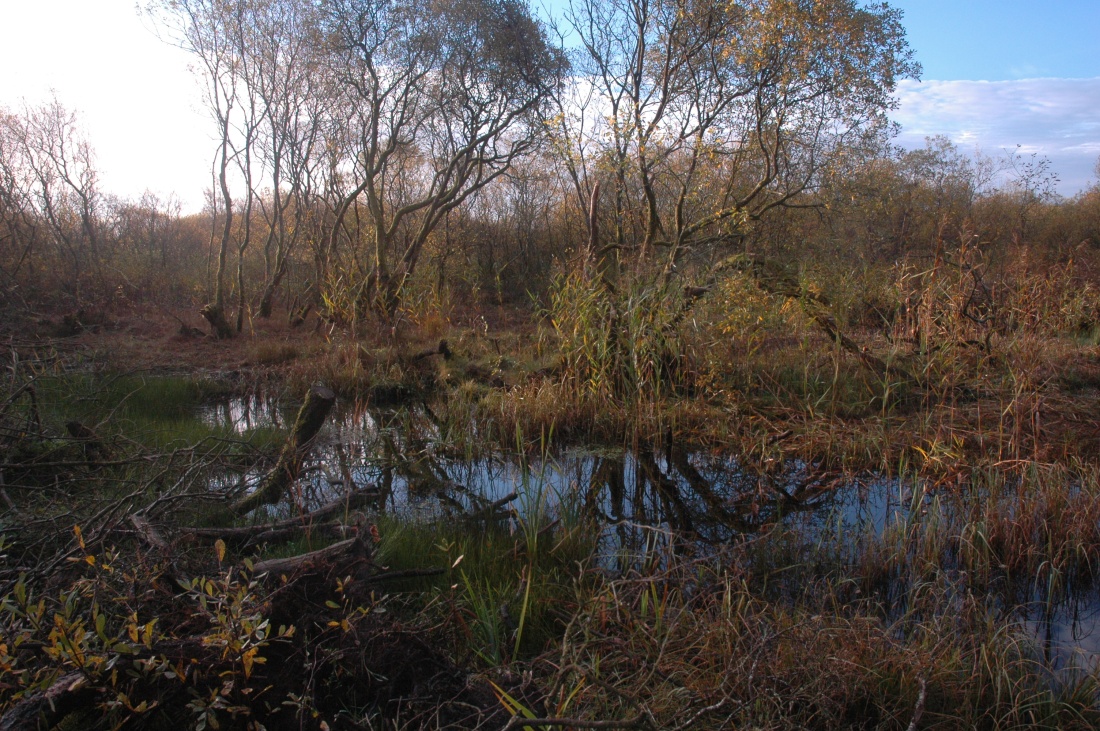
During the summer months we felled out some racks of willow heading initially directly out from the loch shore and so far as possible placing the cut stems at right angles to the rack direction, this became more and more difficult as we progressed further out into the loch, its fair to say that wet feet were the order of the day and its amazing how heavy chainsaw trousers can get when soaked through.
We then took a fairly deep breath and crossed our fingers before tracking the excavator down to the first rack – the instructions to the driver were to put everything he could reach and pick up under the machine to effectively build a timber causeway out into the loch with the excavator clearing a strip of about 7m to each side. This proved to be fairly effective if somewhat nerve wracking for the owner!

We then partially dammed the outlet ditch to raise the water level by about 2 feet and at the same time built in a simple invert system to allow us to drain the water down when appropriate. The result has been successful in terms of attracting waterfowl but in truth we have only scratched the surface of what we hope can be achieved.
WETLAND
One of the problems we have encountered is actually getting access into the woodlands since the commission made little effective provision in this regard. Farmers in general will always try to maximise productivity from any ground and have a natural tendency to try to drain any wet area. It is not always successful.
We had a good example where a channel had been cut through a rock band but really there was insufficient fall to allow the low lying land to drain, and the channel made getting into the wood extremely difficult other than by foot.
So while we had an excavator on site cleaning other (effective) ditches:-
We built a causeway across the channel – using the material previously removed at some unknown time together with the piles of stone gathered off the field over god knows how many generations – and recreated the pond and wetland as shown above – the pond is not great for duck although we get some visitors but the swans like it in the spring. We have counted 8 herons in the wetland and round the pond at one time and the wetland edges can be alive with snipe.
There is a main ditch which runs along one edge of the wetland and one of the many projects on “The List” is to lift the skin of grass off this and return it to an open water channel.


